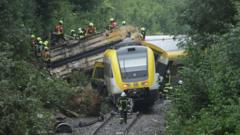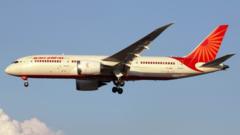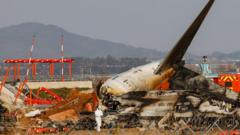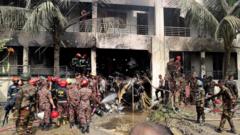Air India Flight 171 experienced a catastrophic crash just moments after take-off from Ahmedabad, raising numerous questions about what went wrong. Investigators are tasked with decoding data from the flight recorders and examining the wreckage to uncover the causes, with all possibilities being explored, from mechanical failures to crew actions.
Investigation Deepens into Air India Flight 171 Crash
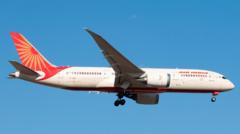
Investigation Deepens into Air India Flight 171 Crash
The investigation into the tragic crash of Air India Flight 171 is unfolding as experts examine wreckage, black boxes, and potential causes.
Article text:
The tragic crash of Air India Flight 171 has ignited a comprehensive investigation following its devastating descent into a crowded area of Ahmedabad shortly after take-off. This incident marks a rare aviation disaster in India's modern history, as the Boeing 787 Dreamliner plummeted within 40 seconds of departure, prompting a detailed analysis of the events leading to the crash.
As investigators begin their meticulous work, they face the challenging task of analyzing the wreckage and retrieving crucial information from the cockpit voice and flight data recorders—also known as "black boxes." According to international guidelines established by the UN's ICAO, a preliminary report on the findings is expected within 30 days, with a final assessment anticipated to be completed within a year.
Air India Flight 171, under the command of Captain Sumeet Sabharwal and co-pilot Clive Kundar, took off from Ahmedabad at approximately 13:39 local time with 242 passengers and nearly 100 tons of fuel on board. Just moments after take-off, a mayday call was reported, followed by a catastrophic loss of altitude that resulted in flames engulfing the aircraft and causing significant devastation.
Expert Captain Kishore Chinta called this a "controlled flight into terrain" incident, emphasizing the unique nature of a crash occurring merely 30 seconds post-departure. Investigators are exploring various scenarios, including the possibility of engine failure from bird strikes or fuel contamination, incorrect flap deployment, or maintenance errors. The investigation process will rely heavily on physical evidence from the wreckage in conjunction with data from the flight records to establish a definitive sequence of events.
Each piece of wreckage, from burnt cables to damaged turbine blades, is being matched with performance data to create a detailed picture of the events leading to the crash. Peter Goelz, a former managing director of the NTSB, indicated that the engines' condition at the time of impact could provide critical clues. If evidence emerges that the engines were not generating power during the crash, attention will quickly shift to the cockpit.
The Enhanced Airborne Flight Recorders aboard the Boeing 787 will offer insights into cockpit communications and flight data, vital for understanding the crew's actions leading up to the accident. The data recorders capture everything from engine performance to navigation inputs, offering a wealth of information that investigators will scrutinize.
The extent of the investigation may hinge on the findings regarding the aircraft's flaps and slats, which are essential for lift during takeoff. Should initial findings indicate that the engines were functioning correctly at the moment of the crash, the investigation could lead to broader implications within the aviation industry, particularly for Boeing, as questions of systemic issues could arise.
To date, preliminary inspections of Air India's Boeing 787 fleet have revealed no significant safety concerns, according to the Indian civil aviation ministry. Collaboration with international experts from Boeing, GE, and regulatory bodies will be crucial as investigators sift through recorded flight data and maintenance records to pinpoint faults.
Investigators are preparing to explore the entire history of the aircraft, from prior maintenance issues to pilot training records, following a meticulous procedure for collecting each fragment of evidence from the wreckage. This thorough approach to analysis is essential, as experts stress that determining what happened may be achievable in the short term, while understanding the underlying reasons could take considerably longer.
The climb in technology utilized in crash investigations means that modern flight recorders can capture extensive data, offering investigators deeper insights into potential causes compared to past incidents. Each piece of information gathered offers the potential to enhance aviation safety and prevent future tragedies.
The tragic crash of Air India Flight 171 has ignited a comprehensive investigation following its devastating descent into a crowded area of Ahmedabad shortly after take-off. This incident marks a rare aviation disaster in India's modern history, as the Boeing 787 Dreamliner plummeted within 40 seconds of departure, prompting a detailed analysis of the events leading to the crash.
As investigators begin their meticulous work, they face the challenging task of analyzing the wreckage and retrieving crucial information from the cockpit voice and flight data recorders—also known as "black boxes." According to international guidelines established by the UN's ICAO, a preliminary report on the findings is expected within 30 days, with a final assessment anticipated to be completed within a year.
Air India Flight 171, under the command of Captain Sumeet Sabharwal and co-pilot Clive Kundar, took off from Ahmedabad at approximately 13:39 local time with 242 passengers and nearly 100 tons of fuel on board. Just moments after take-off, a mayday call was reported, followed by a catastrophic loss of altitude that resulted in flames engulfing the aircraft and causing significant devastation.
Expert Captain Kishore Chinta called this a "controlled flight into terrain" incident, emphasizing the unique nature of a crash occurring merely 30 seconds post-departure. Investigators are exploring various scenarios, including the possibility of engine failure from bird strikes or fuel contamination, incorrect flap deployment, or maintenance errors. The investigation process will rely heavily on physical evidence from the wreckage in conjunction with data from the flight records to establish a definitive sequence of events.
Each piece of wreckage, from burnt cables to damaged turbine blades, is being matched with performance data to create a detailed picture of the events leading to the crash. Peter Goelz, a former managing director of the NTSB, indicated that the engines' condition at the time of impact could provide critical clues. If evidence emerges that the engines were not generating power during the crash, attention will quickly shift to the cockpit.
The Enhanced Airborne Flight Recorders aboard the Boeing 787 will offer insights into cockpit communications and flight data, vital for understanding the crew's actions leading up to the accident. The data recorders capture everything from engine performance to navigation inputs, offering a wealth of information that investigators will scrutinize.
The extent of the investigation may hinge on the findings regarding the aircraft's flaps and slats, which are essential for lift during takeoff. Should initial findings indicate that the engines were functioning correctly at the moment of the crash, the investigation could lead to broader implications within the aviation industry, particularly for Boeing, as questions of systemic issues could arise.
To date, preliminary inspections of Air India's Boeing 787 fleet have revealed no significant safety concerns, according to the Indian civil aviation ministry. Collaboration with international experts from Boeing, GE, and regulatory bodies will be crucial as investigators sift through recorded flight data and maintenance records to pinpoint faults.
Investigators are preparing to explore the entire history of the aircraft, from prior maintenance issues to pilot training records, following a meticulous procedure for collecting each fragment of evidence from the wreckage. This thorough approach to analysis is essential, as experts stress that determining what happened may be achievable in the short term, while understanding the underlying reasons could take considerably longer.
The climb in technology utilized in crash investigations means that modern flight recorders can capture extensive data, offering investigators deeper insights into potential causes compared to past incidents. Each piece of information gathered offers the potential to enhance aviation safety and prevent future tragedies.



